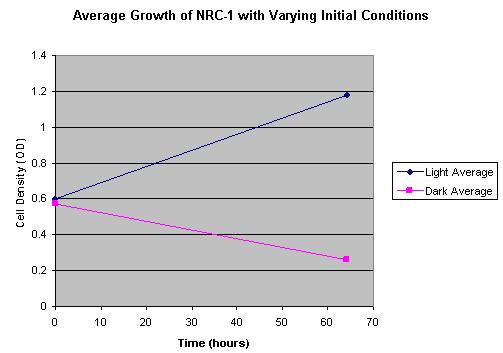
Dark vs. Light (Initial Conditions) LabIntroductionThe purpose of this lab is to determine how initial light conditions of Halo cultures affect their growth in a lighted environment. HypothesisThe Halo in the dark environment will grow less than the Halo in the light environment because the Halo that was previously in the dark environment has to adjust in the light environment because it has to start producing bacteriorhodopsin, which it didn’t have in its dark environment in order to perform photosynthesis. On the other hand, the Halo in the light environment already was producing bacteriorhodopsin, so it already had the energy it needed to grow quickly. Procedure:
1. Arrange six test tubes into two groups: three test tubes for light environment and three test tubes for the dark environment. Results ConclusionAfter 72 hours, the light Halo, the Halo that initially came from a lighted environment, grew the most, having a final OD average of 1.177, while the dark Halo only grew to have an average OD of 0.263. It is possible that the dark Halo grew less because it was not in an active state, compared to the originally lighted Halo. Thus it took more time for the dark Halo to reach its log phase of growth and reproduce rapidly. In fact, since the dark Halo actually died during the course of the experiment, it is possible that the cells stayed dormant throughout the experiment and never grew at all. However, it is unclear whether the reason for the dark Halo’s dormant state was because of its dark environment or because of other external conditions, such as the amount of time it was kept on the shelf before the experiment. Therefore this experiment was inconclusive and should be repeated under more controlled conditions. |
|
Any opinions, findings, and conclusions or recommendations expressed in this material are those of the author(s) and do not necessarily reflect the views of the National Science Foundation. Institute for Systems Biology, 1441 North 34th Street, Seattle, WA 98103-8904 |